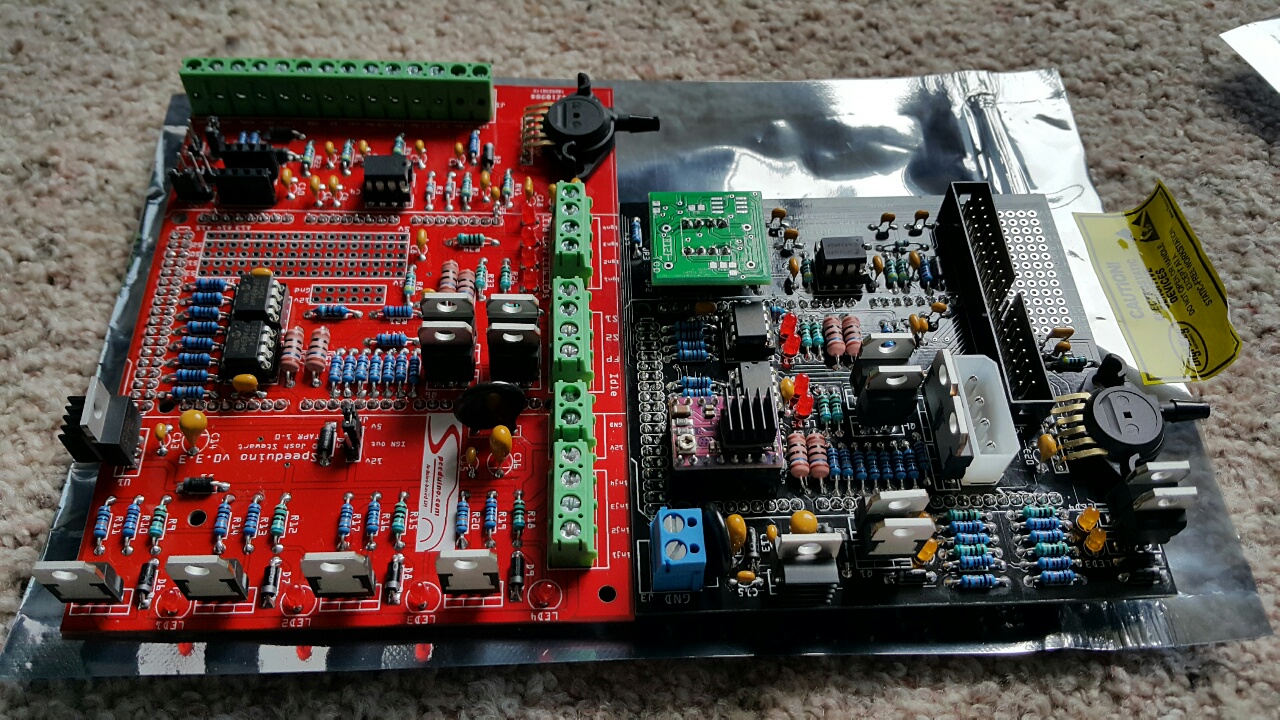So, to make sure I have it straight... you're using an Arduino as the base for a MegaSquirt unit?
Yep, you got it, except I'm using a Speeduino ECM instead of MegaSquirt. The Arduino is the microprocessor that does all the communications, fuel control and (eventually) timing control. I considered MegaSquirt for quite some time, but after a number of searches on the interwebs, I came across Speeduino, which is an Arduino-based ECM. I dare say it is not quite as robust (it seems, anyway) as the MegaSquirt setup, at least in terms of total overall options, but it works great for tinkerers that want to dive head first into EFI projects. Where it does differ, so I've found with the more budget friendly crowds anyway, is that it has four injector drivers instead of two. So the fuel will be a semi-batch (or almost semi-sequential) injection. With a V8, it will be running injector pulses on cylinders that are 360* apart from one another at TDC (1 and 6, 8 and 5, 4 and 7, 3 and 2). The second small PCB that I'll have to build is a variable reluctance conditioner which will be a daughterboard that adds onto the main PCB (pictured a couple posts above). The MegaSquirt package has that already integrated into their main PCB. The VR conditioner modifies the sine wave signal from the distributor's magnetic pickup (that varies in amplitude by RPM, goes both positive and negative) and changes its output to a 0-5V square wave signal required by the Arduino to "see" the RPM. If I were running a Hall sensor off the crank, I wouldn't need to add the VR conditioner.
And tuning it with MS freebie tuner studio... will you stay with that or go to the other paid versions?
Correct. I'll start with the MS freebie version, but may go with the paid version sometime in the future if I have some issues with tuning. The free one has the option for data logging, which will be handy, but you still have to manually change the fuel tables based on your data log. Or you can tune them in real time, but that would obviously be incredibly difficult to do while driving. I don't know that I could train my wife/daughter to make fuel trim adjustments while I drive. She'd be too damn scared to drive the Jeep...why?? lol. The paid version has an Auto Tune feature that will automatically tune and burn the fuel tables while you drive. Only thing is you have to drive with the laptop connected, but whatever...that's only until you get it fully tuned - or at least well enough to live with.
What are you doing for connectivity to all the sensors physical wise... a daughter board full of terminals?
The physical connections will all be done with the red PCB shown above in post #64. Two of the edges will have screw terminals for the sensor/injector leads to be landed. In hindsight, I might should have gotten the Speeduino V0.4x board, instead of the V0.3.7 that I got...they're nearly identical, but the V0.4 has a 40 pin IDC instead of the screw terminals. Either way, I'm going to make an enclosure and jump the leads from the screw terminals to a DB terminal (probably 37) so I have a bulkhead with a removable harness, instead of a harness with an asswad of flying leads... make things much easier! In post #64 above, you can see on the left and top edges of the PCB where the screw terminals are to solder to the board and the sensor/injector leads are to be landed. Those are the ones that I will jump to a DB37.
Once complete, it will look something much like the one on the left here:
The Arduino is mounted under the PCB on header pins (you can see them soldered around the perimeter of the resistors/ICs/MOSFETs in the center of the board). The one on the right above is the V0.4x.
I'm still on the fence about making a bench tester. MegaSquirt sells one for their package that they call a Stimulator...(MegaSquirt...Stimulator...I see what y'all did there!

) I could build one for my Speeduino to do the same thing, and it would be incredibly handy to find issues before I connect it...but, I could also just get the sensors and connect them directly to the screw terminals and do pretty much the same thing. The only other thing I would need to do is connect it to a 12V source...the MegaSquirt Stimulator powers off of a 9V battery, but I don't know the circuitry in this one well enough yet to see that 9V will be enough...time will tell. They may have it split off such that it only needs a 5V reference for the Stimulator to function. I don't know the requirements of these drivers and MOFSETs just yet. So I'll either pair up a couple 9V batteries or get a handful of AA batteries in a couple 4 cell packs and do the same thing. I'd just need to build a square wave generator to make the RPM signal if I want it to think it's running. The reason I said I'm on the fence about it is that I think I'll only need it once...I'd hate to put that much time into something just for that...but on the other hand, I'd be able to learn exactly how the Tuner Studio works, get the IAC working properly, and make sure it all works well before it gets on the engine. So I think I might have just talked myself into making a bench tester. We'll see!














 H 1 1
H 1 1